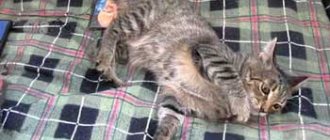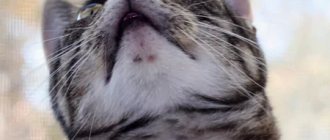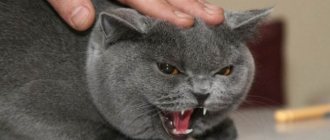7360Pavel
The tail is an important part of the animal's body. If a cat has a sore tail, this can be a serious problem for the whole body, since damage to the spine is possible.
Most often, injury causes tail pain. It is for this reason that cat owners usually turn to a specialist.
© shutterstock
The cat won't let you pet his back
If your cat won't let you pet his back, the reason could be any of the above. The back is one of the most sensitive places in a cat, and sometimes just touching the tip of the fur is enough for the animal to start biting or hissing. Therefore, if an animal does not allow itself to be stroked in this way, it is worth considering whether people have previously treated it cruelly, and in what conditions it lived before that.
You should not exclude the presence of any diseases in the cat. These animals are susceptible to damage to the spine and muscle corset. It should be noted that this is especially often observed in sedentary cats and cats who are afraid to make sudden movements and long jumps. That is why they do their best to protect the back area from any touch. The same is true for the situation when cats do not allow petting of the lower back near the tail.
Joint disease
Joint disease can also cause discomfort in your cat. The tail consists of small joints, so it can also be susceptible to disease.
Most often, this disease is hereditary. Sometimes the problem occurs when there is a lack of calcium in the body. There may be a lack of other microelements.
If the disease is hereditary, the cat will complain not only of pain in the tail, but also in the paws. If there are problems with the joints, the tail will become unplastic.
© shutterstock
The problem can be diagnosed using x-rays. Then the veterinarian will be able to prescribe therapy.
The cat won't let you pet his belly
If a cat won't allow you to pet its belly, there is good reason to assume that people once treated it cruelly, for example, by kicking it intentionally or accidentally. Thus, these animals may well react calmly to touches on the back and other parts of the body, but they defend their stomach with all the fury.
It’s worth adding that cats’ stomachs are even more sensitive than their backs. In this part of the body, many animal breeds have virtually no long hair, so touching the belly can cause persistent discomfort. Or it may be that your cat is simply afraid of the tickling that he feels if he touches the lower part of his body. But the possibility of diseases of internal organs should not be excluded. In this case, cats are especially aggressive and can bite and hiss if you try to touch their belly.
Petting a cat when it doesn't want to
We tend to pet a cat to calm it down when it's anxious or stressed, but doing so can make it feel even worse. The cat may react by avoiding you and therefore not allowing you to touch it.
Anyone who has a cat knows how much these animals love to stare at everything that happens outside the window, especially if they see a bird or insect. When they do this they usually twitch their tail and you notice that they are tense. If you want to touch him right now, the cat will not allow you to pet him because he is focused and also upset: the last thing he needs is to feel a hand on his head or back.
Cats have a hard time accepting new things, so if there are a lot of people, if you've changed the furniture arrangement or moved, the animal needs time and space to get used to it. On the other hand, if what you're doing is trying to calm him down by constantly touching him, it's normal for him to shy away from affection.
If your cat has just been through a traumatic experience (such as a visit to the vet), they will either avoid you or ignore you. They do the same thing when you need to give him medicine or heal his wound.
The cat does not allow itself to be stroked and runs away
Some owners claim that their cat does not allow itself to be stroked and runs away. This can be caused by several factors. This behavior is typical for especially shy or previously wild animals, which are always on the alert and try not to let anyone stranger get close to them. The same is true for overly sensitive cats: the slightest touch to their fur can cause severe tickling.
If you have just recently taken an animal from the street to your home, be prepared for the fact that it will still run away from you for some time. You will have to be patient and wait for the cat to get used to the environment and the people around.
The cat does not allow itself to be petted and bites
Usually the wildest and most aggressive cats do not allow themselves to be petted and bite. Unfortunately, not all animals can be completely tamed or recovered from psychological trauma. Even if the cat receives proper care, it may continue to resist control and at the same time try to harm the person in whom it sees a potential offender.
As practice shows, it is better to lure aggressive animals as often as possible and hand-feed them with their favorite treats. The most courageous and persistent owners even allow their cat to bite and scratch for some time. Sometimes an animal becomes calmer as soon as it sees that its attempts to cause harm are not bringing results, and the hands extended to it look quite friendly.
The cat does not allow himself to be stroked and hisses
When a cat does not allow himself to be stroked and hisses, he is trying to scare away a possible offender. This behavior is also typical of the most aggressive representatives of the cat family, which were raised in the wild or were subjected to violence from people. Most often, such animals not only hiss, but also actively bite and scratch.
Raising a hissing cat can take a long time. You can use the tips described above, or try to find an approach to the aggressive animal yourself. Judging by practice, after some time most animals still become tame, if, of course, they are treated well and stressful situations are not allowed to arise.
The cat does not allow itself to be stroked and screams
If your cat does not allow himself to be petted and screams, it is very likely that he is experiencing unbearable pain. It is important to pay attention to his behavior throughout the day. If he often lies or walks, not finding a place for himself and at the same time not allowing himself to be touched, the matter is clearly a disease of the internal organs.
In such a situation, you need to act as quickly as possible and try to take the cat to the veterinarian. The doctor will perform the necessary procedures, take tests or take x-rays to find the source of the pain. Only timely treatment will help your cat become healthy, cheerful and affectionate again.
A cat has pain at the base of his tail for many different reasons. Do not forget that a pet’s tail is an extension of the spine, so it is important not to neglect the treatment of a four-legged family member. The disease can spread and lead to tail amputation or death.
Fracture
A cat's tail may hurt due to a fracture. The tail is not only part of the spine. It is riddled with nerve endings and blood vessels. When the vertebrae are damaged or displaced, compression of blood vessels and nerve fibers occurs. This causes severe pain in the pet.
Kittens have a more fragile tail than adult animals. Therefore, if your kitten’s tail hurts, you should consult a veterinarian as soon as possible.
In addition to pain, the animal may experience problems with urine output. Why does this happen? This is due to the fact that the nerve endings of the tail and urethra are common. It all depends on the severity of the damage.
Symptoms
The main causes of injuries are unsuccessful falls, being crushed, getting into an accident and other factors. Depending on the degree of complexity, the clinical picture may consist of several symptoms :
- pain – may be accompanied by the pet’s screams;
- visible fracture - you should not try to fix it yourself;
- a gap in the cat's tail - bones will be visible;
- the tail is hot - you can tell by palpation;
- the tail hangs - the pet cannot lift it;
- swelling and redness are evidence of an inflammatory process;
- blood in urine - disruption of the functioning of nerve endings;
- lameness of a cat - a violation in the vertebra;
- bleeding - occurs with an open injury.
Diagnosis and treatment
If you identify symptoms of a fracture, you should contact a veterinarian who can make an accurate diagnosis. He will determine the severity of the damage and prescribe the necessary treatment.
© shutterstock
For diagnosis, a specialist will conduct an examination and order an x-ray. If the animal is incontinent, laboratory tests will be taken.
A fracture or dislocation is treated by applying a fixing bandage. It is tightened so tightly that the cat is unable to bend its tail. Treatment should last 3 weeks. To prevent the cat from removing the bandage himself, you should put a collar on him.
If the tail is damaged closer to the base, it may require amputation. Otherwise, it will be difficult for the cat to defecate. It is best to leave this decision to your veterinarian.
Associated symptoms
Let's look at the main signs of pain near the tail:
- Fracture - in this case, the position of the tail will be lowered, and any impact on your part when trying to raise it will cause pain to the animal.
- Wound (violation of the integrity of the coat) - scratches and abrasions can be obtained during a fight with other cats or due to the carelessness and carelessness of the animal.
- Hair loss can also be the reason why a cat won't allow the base of its tail to be touched due to pain. A fungal growth or infection causes these symptoms.
- Fear - If a cat is afraid of something or has been beaten and humiliated repeatedly, the tail will be feathered and the base will hurt. Therefore, every touch to the animal will be accompanied by loud screams and plaintive meows.
- Allergies can occur both to food and household items (cleaning products, perfumes).
- Worms - development in the body will lead to pain in various parts of the body, including at the base of the tail.
It is sometimes almost impossible to determine the diagnosis on your own; even an experienced veterinarian in such cases, without appropriate diagnostic measures, will not be able to determine the disease by eye, so you should not delay going to him.
Causes of pain
If a back injury occurs, which could occur during a fight with other cats, an accident involving him, or an unfortunate fall, then you should limit his activity and immediately take him to the veterinarian.
Even a small wound can cause severe torment and pain not only in the area of the base of the tail. Also, a similar condition, when a cat has pain near the tail, will cause a tumor. In this case, the cat’s behavior will become passive and lethargic, and when you start stroking it, it may meow pitifully or begin to hiss. This will happen because you may have touched a sore spot.
There is a possibility that the cat was already born with some defects in the back and base of the tail. Nowadays this is not uncommon, because the cold-blooded and reckless attitude towards cats of breeders who, for their own benefit, cross certain types of different breeds, leads to mutations of the spine, muscles and ligament rupture. In the event of a ligament rupture, severe pain occurs, which can be prevented by wearing a special bandage. He will record the position throughout the year if the diagnosis is confirmed.
Uncomfortable sensations cause joint disease. Most often, this disease is hereditary and other symptoms appear. There may also be pain in the paws, and the tail will always be down and motionless.
Treatment
Providing first aid to a pet in a timely manner can save its life.
If there is a fracture, the cat should be placed at rest and carefully transported in a carrier, taken to a veterinarian. After the examination, an x-ray is taken and the necessary medications are prescribed. In some cases, a cast is applied. If scratches and wounds occur or hair loss occurs in the tail area, sulfur ointment is used, which is sold at any pharmacy. It does not dry out the skin and promotes rapid healing.
The most common problem in domestic cats is worms. Anti-inflammatory agents and a proper diet with the addition of vitamins can help remove them, which will not only have a beneficial effect on health, but will make the coat smooth and silky.











